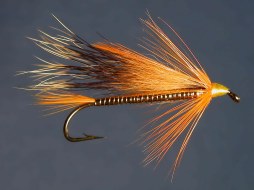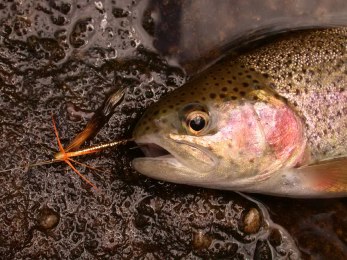Invicta Flies - Woodchuck Special
Created by Peter Frailey of Massachusetts, the Woodchuck Special takes advantage of the combination of guard hairs and underfur to create not only a translucent silhouette, but amazing movement as well. The orange hackle compliments the golden tones of the woodchuck fur, and the gold body gives a warm flash to tie the illusion together. Top it off with a nice yellow head, and the result is a simple, pure, work of art. Simple, sure, but drop it in a clear stream, and it seems as though a ray of the setting sun has been trapped in the current and become a nervous, glowing, creek dace.
Visit Peter's website, Fishing With Flies, for some more of his great patterns, stories by flytiers, and more!

Hook: Mustad 3665A, #6-8, or other streamer hook
Thread: Danville's Prewaxed 6/0, yellow
Tail: orange hackle fibers
Body: fine gold tinsel
Ribbing: fine gold wire
Wing: woodchuck hair
Collar: orange
Tying Instructions:
1) For weight, spiral .015 lead wire onto the front half of the shank, leaving about two hook-eye widths for the head. Attach the tying thread in front of the lead and wrap back and forth over it five times to secure. Cement the wraps and bring the thread behind the lead wire.
2) Lash the wire ribbing to th bottom of the shank as you wrap the thread back to the bend. The excess should now be extended beyond the bend.
3) At the bend, tie in orange hackle fibers for a tail, length approximately equal to the hook gap. Trim the butt ends at an angle...this will assist in smoothing the transition to the wide portion of the body that contains the lead wire. Cover the butt ends with wraps of the tying thread.
4) Lash the gold tinsel to the top of the shank, excess beyond the bend. Use the tying thread to build up a smooth foundation and gradually taper to the thickness of the lead wire. Bring the thread to just in front of the lead wire.
5) "Fold" the tinsel over and down the far side, then wrap it up the shank in tight turn to the tying thread. Make the last wrap at the front edge of the lead wire, the another in front of the wire on the shank at the tying thread. Take three tight turns of thread to secure, then clip the excess.
6) Tightly wind the ribbing over the tinsel in the same direction forward in a close spiral. Tie down in front of the lead wire and clip the excess.
7) Even the tips a little of a small clump of woodchuck fur while still on the skin, and clip about a 1/3 matchstick size clump. Tie this in on top of the hook shank directly in front of the body. Woodchuck is a little slippery, so you may want to tie this in as two seperate smaller clumps. The tips should reach just barely beyond the tip of the tail (a hook eye width or so). Stagger clip the butt ends. Apply a drop of head cement, allow a moment for it to soak in, then cover with the tying thread.
9) Select an orange saddle hackle feather with fibers about half as long as the woodchuck wing. Fold the fibers (or simply stroke them rearward as you wind), and tie it in by the butt. Take four or five turns, tie down, and clip the excess. Alternately, you can tie the feather in a little forward, then wind rearward and incorporate the remaining tip as a topping for the wing. Wind the thread back a couple turns over the hackle stems for added strength.
10) Build a smooth, tapered head with the tying thread, whip finish, clip the thread, and cement the head.
Variations: Yellow tail and hackle, or red tail and hackle. You can also use medium copper wire for the ribbing, which will also help weight the fly in place of lead wire.
Fish the Woodchuck Special as any other streamer, on the swing, varying strips, fast and slow. Trout and bass run quite a distance to nab this streamer, so work it all the way in.
